Porringers & Bleeding Bowls
Porringers & Bleeding Bowls
In the past, people from all levels of society took their food in forms unfamiliar today. Everyday nourishment depended heavily on eggs, milk, oats and grains. Ale, sack mead, wine, spices, sultanas and sugar were added for flavor. The gruel, porridge, potage (soup), caudle and other sloppy warm mixtures were partially drunk and partially eaten with a spoon. They were served in 2 handled cups, often with a cover to keep it warm.
Browse our collection of specialist silver porringers and bleeding bowls. An excellent range of early silver examples for the collector which are ideal for practical use and make a perfect gift.
Originating from the mid 1600’s, Silver Porringers are two handled bowls and some have a cover. They can also be known as caudle cups although the origin of the porringer was for porridge and the caudle cup was for a type of broth. From the eighteenth century onwards, porringers and cups and covers were used mainly as centrepieces or ornaments. In recent times they have seen a resurgence in popularity for drinking and on the dining table. They make a very attractive baby gift.
Silver Bleeding Bowls may have been used for medical purposes however many people think that these shallow bowls were more likely to have been eating vessels, especially for feeding the sick. Nowadays they make useful serving bowls which are handy for nuts and sweets. The first examples were straight sided and had a simple rim but as the 17th century progressed the form became more bulbous and topped by a thin narrow band at the rim.
-

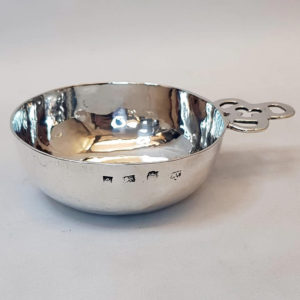
1625
Robert Profit
9989 Charles I Antique Silver Bowl
Sold
An extremely early date. A rare antique silver porringer (or bleeding bowl) of plain circular form. The straight sided shape with a simple rim is the earliest type and in keeping with the early date. Small proportions and very charming with the original hand beaten finish. A useful serving bowl, handy for nuts and sweets. Prick marked on the edge of the rim with the initials “MC”. Weight 108 grams, 3.4 troy ounces. Diameter 10.3cm. Height 3.5 cm. Spread 14cm. London 1625. Maker “RP” possibly Robert Profit (David Mitchell’s “Silversmiths in Elizabethan and Stuart London”).
-

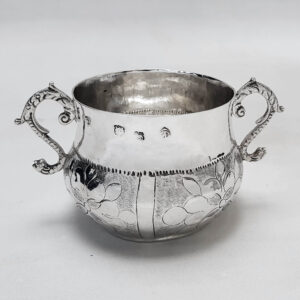
1662
Edward Treen
10339 Charles II Antique Silver Porringer
A very early English twin handled silver cup with cast serpent form side handles. This little porringer (or caudle cup) combines some of the austere decoration associated with the Commonwealth period with the addition of hand engraved flowers marking the transition into the joyful Restoration period of Charles II. Superb colour. An attractive feature is the decorative base, very reminiscent of sweetmeat dishes of this period. Contains 250ml. Weight 113 grams, 3.6 troy ounces. Diameter 7.7 cm. Height 7cm (to top of handle). London 1662. Maker Edward Treen, specialist cup, porringer and sweetmeat dish maker. Sterling silver.
-

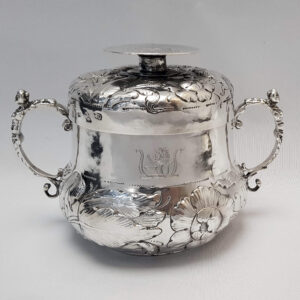
1666
Gowen Udall
10368 Charles II Antique Silver Porringer
Sold
A magnificent piece of early English silver. A large 2 handled antique silver cup and cover with caryatid handles; the body decorated all round with deep relief flowers and foliage typical of this early date. The hand beaten finish is very appealing. The matching cover has a capstan shaped finial so that the lid can be turned upside down and used on its own as a saucer. The lid finial bears a large hand engraved armorial with a crest and motto; the crest is repeated to the front and reverse of the porringer body. The underside has a large presentation inscription dated 1666. Weight 603g, 19.3 troy oz. Spread across handles 20cm. Height 14.5cm (total), 11.2cm (top of handle), 10.5cm (top of body). Diameter 11.8cm. London 1666. Maker probably Gowen Udall – source David Mitchell’s “Silversmiths in Elizabethan and Stuart London”. Sterling silver.
-

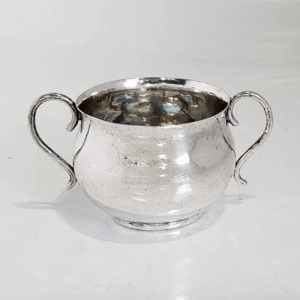
1673
8394 Charles II Antique Silver Brandy Cup
A rare early English silver tot cup, or small size porringer, with twin side handles and belly shape. Lovely original hand beaten finish. Lovely original hand beaten finish. Weight 69 grams, 2.2 troy ounces. Height 5.5 cms. Diameter 6 cms. London 1673. Maker IC* listed in Jacksons.
-

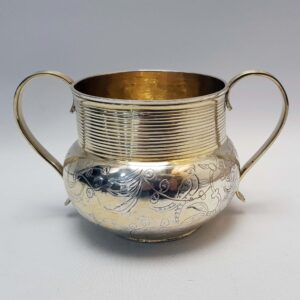
1678
Thomas Roman
10421 Charles II Antique Silver 2 Handled Cup
This beautiful chinoiserie silver cup must be almost unique. The body is raised from sheet and has simple strap handles and an incised, reeded neck. This is similar in form to the earliest type of mug which was only made during a short period at the last quarter of the 17th century. The cup (or porringer?) is made completely by hand, and has a gilt silver finish. The body is stunningly decorated with a hand chased chinoiserie scene depicting exotic birds and plants in a tropical forest. Weight 254grams, 8.1 troy oz. Height 11cm (top of handle), 10.5cm (top of neck). Spread across the handles 18.5cm. Diameter 10.3cm. London 1678. Maker Thomas Roman. Sterling silver.
-

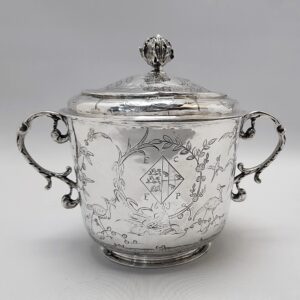
1683
Robert Cooper
10383 Charles II Antique Silver Porringer
Sold
A rare early English silver cup and cover with finely engraved chinoiserie decoration to the body and lid. Large size and good heavy weight. The fantastical Chinese forest landscape contains exotic long tailed birds and spidery plants depicted in beautiful hand chased ornament. To the front there is a widow’s armorial, owner’s initials, and the date “1683”. The shaped handles are typical of this early period. Weight 575g, 18.4 troy oz. Height 11.2cm (to rim), 17.5cm (to top of finial). Spread 21.8cm. Diameter 14.1cm. London 1683. Maker Robert Cooper. Sterling silver. 17th century.
-

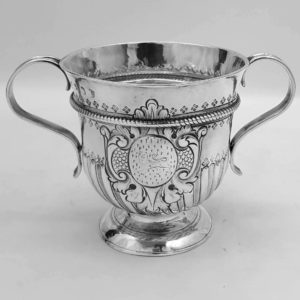
1717
Thomas Parr
9930 George I Silver Porringer
A fine antique silver porringer with bands of ribbing to the lower body and a broad rope twist band above. Britannia standard silver*. Good size. Hand engraved to the front within an expansive embossed cartouche, typical of the Queen Anne period, is an armorial crest of a lion. Excellent patina. Contains 930ml. Weight 436 grams, 14 troy ounces. Height 13.8cm. Diameter 13cm. Spread 20.5 cm. London 1717. Maker Thomas Parr.